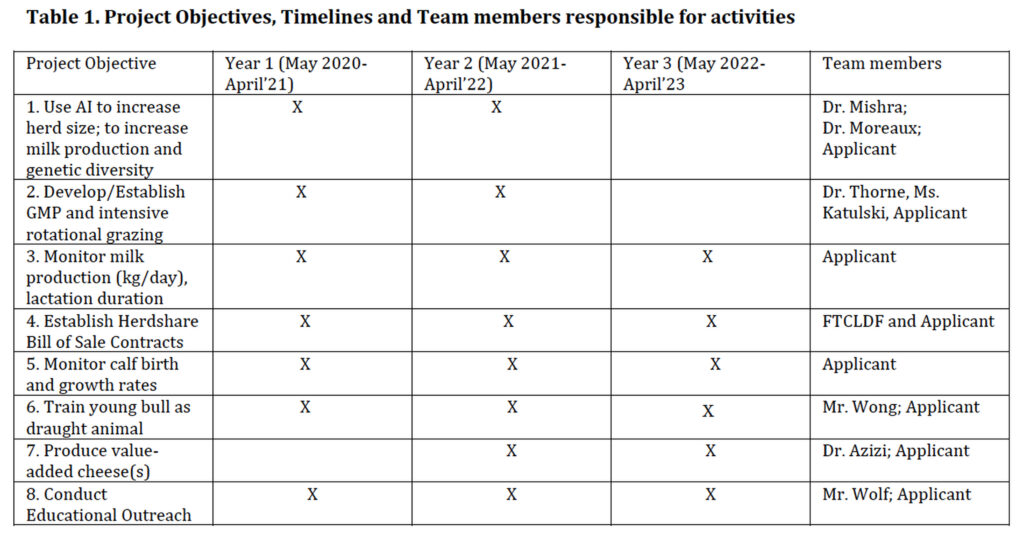Final report for FW20-366
Project Information
This project will demonstrate that the integration of multi-functional dairy water buffalo (Bubalus bubalis), using holistic management techniques, into Kauai Organic AgroecoSystem’s (KOA) 25-acre integrated aquaculture (tilapia)-agriculture (taro) commercial organic agroforestry farm in Hawaii will improve the economic, ecological and social conditions of our whole farm system. KOA will produce organic raw milk and associated value-added products (e.g. cheeses) for our local community via “herdshare agreements and bill of sale”. Also we will train our young bull as a draught animal to harrow, puddle, and level our taro pondfields, to pull a wagon of fresh produce to farmer’s markets, to pull a wagon full of “agrotourists” around our farm during farm tours, and for logging.
Our small dairy buffalo herd, the first in Hawaii, is composed of 4 adult buffalo cows (3 are lactating, another due to calf in December), 2 cow calves, one bull calf . Furthermore, our 3 currently lactating buffalo cows are scheduled for artificial insemination (AI) on November 18 this month and would calve again in September 2020.
Because Hawaii imports virtually 100% of its dairy products, we plan to provide our local community with fresh, organic, raw milk, and value-added products like cheeses and butter, from grass fed pastured buffalo. Our dairy buffalo will reduce our dependency on imported dairy products, increase our net economic returns, reduce our fossil fuel and fertilizer imports, help to control invasive wetland weeds, and improve endangered Hawaiian water bird habitat. Ultimately, we plan a "dairy buffalo cooperative" with producers throughout Hawaii and the Pacific.
1) Use artificial insemination (AI) to expand herd (Dr. Mishra; Dr. Moreaux; Applicant); Yr 1-3
2) Develop/implement Gazing Management Plan (GMP) and intensive rotational grazing system (Dr. Thorne; Ms Katulski; Applicant); Yr 1-2
3) Produce raw milk and/or value-added products (e.g., mozzarella cheese), (Dr. Azizi, Cheese maker; Applicant); Yr 1-3
4) Establish “Herdshare Agistment and Bill of Sale” contracts with local consumers to allow their access to raw, nutritional milk (FTCLDF; Applicant); Yrs 1-3
4) Measure milk yields (kg/day), duration of lactation (Applicant); Yrs 1-3
5) Measure calf birth, weaning and growth rates (kg/day), monitor average daily gain (ADG) in weights of calves, measure gain per/acre/groups of calves/month (Applicant; Ms. Katulski); Yrs 1-3
6) Train buffalo bull for draught for taro production, for pulling wagon of fresh produce to the farmer’s markets and agrotourism (Mr. Wong, Oxen Trainer; Applicant); Yrs 1-3
7) Compare draught buffalo power to tractor power for harrowing taro pondfields , quantify cost savings in fossil fuel use reduction (Applicant); Yr 2-3
8) Begin farm tours (agrotourism) with draught bull and wagon (Applicant); Yr-3
9) Conduct educational outreach via farm workshops, field days, PowerPoint presentations, YouTube videos, Surveys and other social media (Mr. Wolf, Video Producer; Applicant). Yrs 1-3
May 2020 (Year-1):
1) Implement all aspects of the GMP;
2) Record milk yields (kg/day/buffalo cow), duration of lactation, calving intervals;
3) Establish herdshare contracts to provide organic raw milk to local consumers;
4) Begin training of our buffalo bull for draught power;
5) Begin making value-added organic cheeses;
6) Give five public PowerPoint presentations;
7) Submit WSARE annual report;
Year-2:
8) Hold four Farm Workshops for producers;
9) Four YouTube videos based on these Workshops;
10) Begin monitoring calf birth and growth weights;
11) Conduct marketing surveys to assess demand for “mozzarella di bufala”;
12) Submit WSARE annual report;
Year-3:
13) Begin farm tours with draught bull and wagon;
14) Give 5 final PowerPoint presentations including all of project’s objectives and findings;
15) Produce final YouTube video of project, submit to WSARE (and final project report), Kauai Public TV (Ho’ike), Kauai Public Radio (KKCR) and to Kauai Public Libraries.
Cooperators
- - Producer
- (Educator and Researcher)
Research
The Integration of Bubalus bubalis into a whole farm system in Hawaii:
economic, ecological and sociocultural benefits.
KOA FARMS - DON HEACOCK
Western SARE Project Report, Final Report, Year 3, 2023 (extended to January 30, 2024)
(Project Award # FW20-366 and MSU award number: G332-20-W7900);
completed January 30, 2024
Summary:
Table 1. A summary of the dairy water buffalo project objectives, timelines, and team members.
|
Project Objectives |
Year 1 May 2020 - April 2021 |
Year 2 May 2021 - April 2022 |
Year 3 May 2022 - January 2024 |
Team Members |
|
1. Used AI to increase herd size, to increase milk production and herd diversity. |
X |
X |
Recipient and Dr. Birendra Mishra, DMV |
|
|
2. Developed and established Rotational Grazing Management Plan (RGMP) |
X |
X |
Recipient and Robert Bristol |
|
|
3. Monitored milk production and period of lactation. |
X |
X |
X |
Recipient and Robert Bristol |
|
4. Established herd-share bill of sale contracts. |
X |
Recipient and Food to Consumer Legal Defense Fund |
||
|
5. Monitored calf birth and growth rate. |
X |
X |
X |
Recipient and Robert Bristol |
|
6. Trained young bull as a draught animal. |
X |
X |
Recipient and Robert Bristol |
|
|
7. Produced value-added cheese. |
X |
X |
Recipient |
|
|
8. Conducted educational outreach |
X |
X |
X |
Recipient and Shelby Webster (videographer) |
Objective 1: Used AI (artificial insemination) to increase herd size, to increase milk production and herd diversity.
In May 2018, Kauai Organic Agroecosystems (KOA Farms) imported four pregnant heifer dairy water buffalo from Turkey Creek Water Buffalo ranch in Texarkana, Arkansas.
The heifers calved on August 23, 26, 27, and November 19, 2018 producing three female (cow) calves and one male (bull) calf.
As reported in the Year 1 Annual Report (March 2021), Dr. Birendra Mishra, DVM, and Don Heacock used imported frozen Italian dairy buffalo bull semen to AI three of the adult buffalo cows on December 6, 2019. All three of these cows had calves that were fourteen months old and had been weaned at seven months old. Unfortunately, none of the three artificially inseminated adult buffalo cows became pregnant. It is important to note that buffalo have “silent estrus” which makes AI very difficult (i.e., very low pregnancy success rate) when compared to cattle.
For this reason, mature bull (“Kekane”) was put in the same paddock with the seven adult buffalo cows in December 2020, which has resulted in four new calves born in 2021 (see Objective 5 below). Because the primary goal was herd-building, cows were only milked occasionally to allow the calves to grow as strong and big as possible in the seven months before weaning (see Milking Video).
In order to circumvent the difficult task of timing AI with the silent estrus of the water buffalo, three yearling dairy water buffalo were purchased and imported from Canada in April 2023 (Figure 1a.) The importation of dairy water buffalo was only approved by the USDA starting in February 2023, KOA Farms being the first farm in the US to do so. These dairy water buffalo originated from top-milk-producing Bulgarian stock imported to Canada in 2001. They produce roughly two to three times more milk compared to the existing dairy buffalo stock in the US that had been obtained from zoos, animal parks, private collections, etc. with minimal or no records of milk production or pedigree. The three Canadian dairy buffalo , 1 bull named Kaniela and two heifers named Kila and Manu, arrived at KOA Farms in April 2023. (Figure 1b.)
AI was not attempted in year three because of the herd’s existing genetic diversity and the importation of the Canadian buffalo. Additionally, the original four heifers imported from Arkansas were impregnated by three different select dairy buffalo bulls. In the future AI may be used with the help of a “marker bull”, equipped with a marking collar and chastity belt, to show when cows are in estrus without impregnating them, allowing AI to be used at the right time.
A more detailed breeding program is being developed with the help of technical advisor Birendra Mishra, DVM.
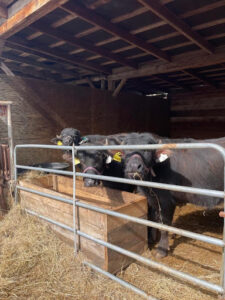
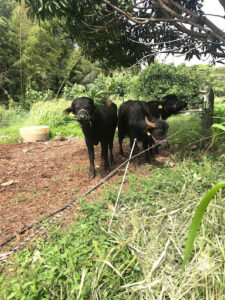
Objective 2: Developed and Established GMP (Grazing Management Plan) and intense rotational grazing.
A video produced by KOA Farms is available on Youtube titled, “How KOA Established a Rotational Grazing Management Plan (RGMP) for Dairy Water Buffalo.” (https://youtu.be/4qPE-9FOXpI) as well as Ho’ike (Kaua’i Public Access TV1).
During the first year of this project methods described by Thorne, Fukumoto and Stevenson 2007a2, Thorne and Stevenson 2007b3, by Savory Holistic Management with Intense Rotational Grazing (Savory Institute 2021) were used. Nine grazing paddocks were developed (Figure 2), averaging about 2.5 acres (range = 2.0 - 4.5 acres). Generally, buffalo are grazed in smaller paddocks 1, 2, 3, 7, and 9 (Figure 3) for 1-2 day intervals. Larger paddocks 4, 5, 6, and 8 for 2-3 day intervals, and occasionally 4-5 day intervals depending on rainfalls. Paddock 4 has been expanded to approximately double the previous acreage.
Paddocks are dominated by tropical Guinea grass (Megathyrsus maximus) (Figure 4) and the legume Leucaena glauca, both highly invasive but excellent forage species for buffalo. Approximately 60-75 inches of rainfall spaced relatively evenly through the year, combined with very fertile soil, allows grass to grow and recover quickly after grazing, usually within 6-7 days (Figure 7).
Unlike cattle or bison, domestic water buffalo also brose readily on leaves of several other invasive trees and plants including Macaranga grandifolia, Brassia actinophylla (umbrella tree), Chrysophyllum oliviforme (satin leaf tree) (Figure 5), Hibiscus tiliaceus; hau (Figure 6) Clusia rosea (autograph tree or copey), Syzygium cumini (Java plum), Schinus terebinthifolius (Christmas Berry tree), Operculina tuberosa (the woodrose vine), Albizzia lebbeck (Siris tree). Although Albizzia, one of the worst invasive species on Kaua’i, are very large and the buffalo cannot reach the canopy, they will eat seedlings and any resprouts on cut stumps. In addition to the previously listed species water buffalo will also eat invasive bamboos and four species of invasive aquatic weeds; Commelina diffusa (honohono), Typha angustata (cat tail), Cyperus involucratus (the umbrella sedge), and Coix lacryma (Job’s tears).
Exceptional calf growth rates (see objective 5) and excellent condition of the buffalo cows and bulls demonstrate that the rotational grazing management plan (Figure 7) is working very well.
At KOA Farms dairy water buffalo are integrated into a larger taro cropping system. Buffalo eat/clear grasses and weeds out of fallow taro fields (Figure 8) to help fertilize and prepare the fields for replanting, thereby avoiding the use of gas-powered weed-eaters, reducing fossil fuel, labor and fertilizer costs. Integrated aquaculture (tilapia)- agriculture (taro) is one of KOA’s primary economic drivers (Figure 9). This system showed significant ecological and economical benefits, and is modeled after the traditional Hawaiian “loko ia kalo” (fishponds with taro).
1 To view KOA Farms’ RGMP on Ho’ike go to: Ho’ike.org, Watch Now, Video On Demand, Videos, then Search for Water Buffalo.
2 Thorne, M.S., G. K. Fukumoto and M.H. Stevenson. 2007a. Foraging Behavior and Grazing Management Planning. Pasture and Range Management, PRM-2, CTAHR, University of Hawaii, Honolulu, 1-11pp.
3 Thorne, M.S. and M.H. Stevenson. 2007b. Stocking Rate: the most important tool in the toolbox. Pasture and Range Management, PRM-4, College of Tropical Agriculture and Human Resources (CTAHR), University of Hawaii, Honolulu, 1-10pp.
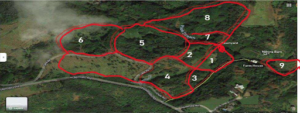
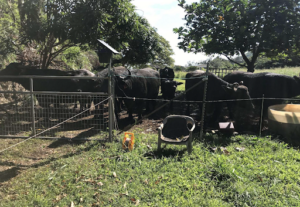
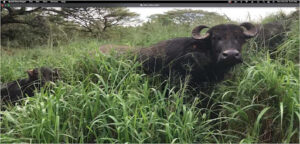
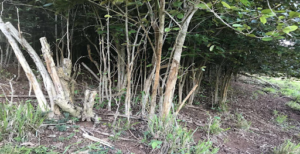
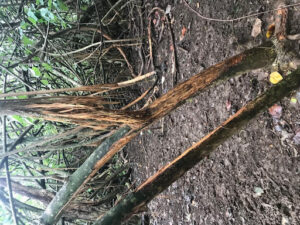
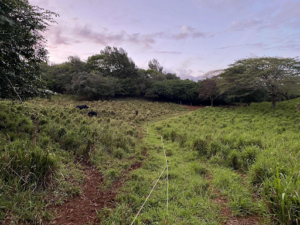
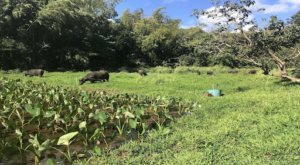
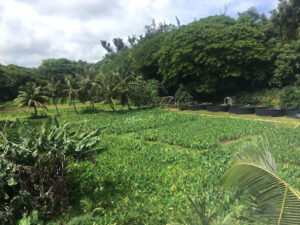
Objective 3: Monitor milk production and period of lactation.
As the primary goal has been herd building, it’s desirable for calves to grow as fast and strong as possible, therefore consuming as much milk as possible is vital. Buffalo cows have only been milked occasionally in the seven months before weaning their calves but were able to produce between 0.75 and 1.5 gallons of milk per milking per cow. A short video of the milking process can be seen on the farm’s website (www.kauaiorganicagroecosystems.org) or hosted on archive.org (https://archive.org/details/milking-a-water-buffalo).
Although twice-daily milkings were planned to start by April 2022, it became apparent that his objective was premature due to its conflict with herd-building. Additionally, unforeseen increases in building and labor costs for our commercial kitchen also delayed this project objective; full time milking is now planned for May or June 2024, making cheese shortly after.
Additionally, an extension to the milking and corral area has been built to handle the milking of buffalo cows more easily. Compare the previous facilities (Figure 10) to the milking area extensions built in 2021 (Figure 11).
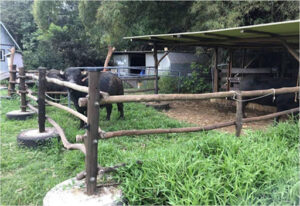
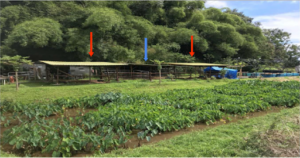
Objective 4: Development of a herd-share and bill of sale contracts.
As Hawaii is one of the seven states in the US that does not allow the sale of raw milk, KOA Farms worked with the Farm to Consumer Legal Defense Fund (FCLDF) attorneys, using Hawaii state contract law, to develop a herd-share agistment contract and an associated bill of sale to provide local consumers with raw milk.
Raw milk has abundant digestive enzymes, probiotics, minerals, and vitamins (A, C, D, B1, E, K), almost all of which are destroyed by pasteurization4. As of January 2024, KOA Farms has received 61 requests from local families and individuals to purchase herdshare agistment contracts and associated bills of sale. These local families would pay KOA Farms a monthly fee to feed, care for, and milk their buffalo for them. It is important to note that this is not a sale of milk, the families own the milk since they own part of the herd. Additionally, please see the discussion (section 5) of multi-functional dairy water buffalo as both milk and meat producers, meat will also be included in a future herdshare agistment contract and bill of sale with members of our community that want this organic, nutrient-dense and health-promoting grass fed buffalo meat.
As compared to the meat of cattle and bison, water buffalo meat is lean and rich in protein, lower in cholesterol and fats, high in conjugated linoleic acids (anti-cancer and good for cardiovascular system5), and the meat is significantly higher in vitamins, minerals and iron6.
4 Sozanska,B. 2019. Raw Cow’s Milk and Its Protective Effect on Allergies and Asthma. Nutrients 11(2): 469
5 Giordano G, Guarini P, Ferrari P, Biondi-Zoccai G, Schiavone B, Giordano A. 2015. Beneficial impact on cardiovascular risk profile of water buffalo meat consumption. Angiology Unit, Villa del Flori Hospital, Acerra (NA), Italy. ggiord@libero.it
6 Valin, C. et al. 1984. Comparative study of buffalo meat and beef.Meat Science, 10 (1): 69-84.
Objective 5: Monitored calf birth and growth rate.
Based on the growth rates measured in 2022 and 2023, calves grown at KOA Farms have grown faster and larger than those listed in the literature on dairy water buffalo calf growth in Italy and Bulgaria7, in the USA in Arkansas8, and at the Central Institute for Research on Buffalo in India9 where it was found that dairy water buffalo optimal growth rates were between 500-600g (1.1-1.3 lbs) per day. In Brazil optimal growth rates were between 700-800g (1.5-1.7 lbs) per day (Silva, et al. 2021). In contrast, KOA Farms calves’ had excellent average growth rates of 1323.5g (2.92 lbs) per day for 2022 and 1417.1g (3.12 lbs) per day for 2023. These growth rates are visualized in (Figure 12). The difference in these growth rates are likely due to the abundant and high-quality forages found in the tropical Niumalu, Kaua’i pastures, the high protein and high butter fat levels found in buffalo milk, and the intensive rotational grazing management program which optimizes forage production and animal weight gain.
It is important to note that half of calves born at KOA Farms will be bulls and the ones not selected for breeding will be butchered for meat at two years old (~1,400 lbs live weight) yielding roughly 850 lbs of meat worth roughly $6-7,000. While the original grant proposal submitted to WSARE had a greater focus on dairy production, making herd building the priority of the project has meant some of that original focus has been shifted to producing meat.
Because buffalo meat has very low amounts of intermuscular fat, the meat is very low in cholesterol, lower than that of bison, beef, turkey, venison, or chicken. (Figure 13) Compared to beef, buffalo meat has 11-30% more protein and is 10% higher in minerals.5 Additionally buffalo meat is a good source of protein and iron and the consumption of buffalo meat was associated with several beneficial effects on cardiovascular risk profile.5 A larger consumption of water buffalo meat could confer significant cardiovascular benefits, while continuing to provide a substantial proportion of the recommended daily allowance of protein and essential amino acids.5
More detailed information on the 15 calves born in 2022 and 2023, including their average daily weight gains can be found in tables 2, 3, and 4.
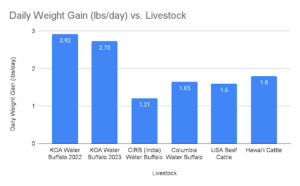
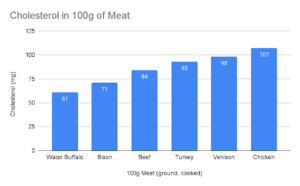
Table 2. Record of calves born in 2022, sex, names, and pedigree information
|
Number Born @KOA Farms |
Tag |
Date of Birth |
Sex |
Name |
Sire (tag) |
Dam (tag) |
# calf born to dam |
|
1 |
002 |
8/11/2022 |
F |
Mahina |
Kekane (0-36) |
Lani (71AKP6971) |
3 |
|
2 |
007 |
8/16/2022 |
M |
N/A |
Kekane (0-36) |
Buffy (0-35) |
1 |
|
3 |
005 |
9/6/2022 |
M |
N/A |
Kekane (036) |
Kala (0-34) |
2 |
|
4 |
004 |
10/13/2022 |
M |
N/A |
Kekane (036) |
Koko (71AKP6969) |
3 |
|
5 |
008 |
10/17/2022 |
F |
Ewalu |
Kekane (036) |
Ipo (71AKP6973) |
2 |
|
6 |
006 |
10/27/2022 |
M |
N/A |
Kekane (036) |
Ua (0-37) |
1 |
|
7 |
009 |
12/21/2022 |
F |
Eiwa |
Kekane (036) |
Pua (71AKP6970) |
3 |
Table 3. Record of calves born in 2023, sex, names, and pedigree information
|
Number Born @KOA Farms |
Tag |
Date of Birth |
Sex |
Name |
Sire (tag) |
Dam (tag) |
# calf born to dam |
|
8 |
011 |
8/12/2023 |
F |
N/A |
Kekane (036) |
Kala (031) |
3 |
|
9 |
012 |
8/25/2023 |
M |
N/A |
Kekane (036) |
Buffy (001) |
2 |
|
10 |
013 |
8/26/2023 |
M |
N/A |
Kekane (036) |
Lamalani (0-40) |
1 |
|
11 |
010 |
8/30/2023 |
F |
Baby |
Kekane (036) |
Lani (71AKP6971) |
4 |
|
12 |
014 |
8/31/2023 |
F |
N/A |
Kekane (036) |
Koko (71AKP6969) |
4 |
|
13 |
015 |
9/15/2023 |
F |
N/A |
Kekane (036) |
Ku'uipo (71AKP6973) |
3 |
|
14 |
016 |
10/7/2023 |
M |
N/A |
Kekane (036) |
Ua (0-37) |
2 |
|
15 |
017 |
11/28/2023 |
M |
N/A |
Kekane (036) |
Pua (71AKP6970) |
4 |
Table 4. Growth rates of seven calves born in 2022 with an average daily weight gain of 2.92 lbs.
|
ID |
Age at First Weigh |
Date Weighed |
Weight (lbs) |
Weight Gain (lbs/day) |
|
Heifer-002 |
10 days |
21 August |
99 |
|
|
22 September |
183 |
2.63 |
||
|
24 October |
279 |
3.00 |
||
|
28 November |
377 |
2.80 |
||
|
21 December |
443 |
2.87 |
||
|
Bull-007 |
5 days |
21 August |
103 |
|
|
22 September |
197 |
2.94 |
||
|
24 October |
289 |
2.88 |
||
|
28 November |
389 |
2.86 |
||
|
21 December |
459 |
3.04 |
||
|
Bull-005 |
16 days |
22 September |
126 |
|
|
24 October |
219 |
2.91 |
||
|
28 November |
321 |
2.91 |
||
|
21 December |
391 |
3.04 |
||
|
Bull-004 |
11 days |
24 October |
101 |
|
|
28 November |
211 |
3.14 |
||
|
21 December |
281 |
3.04 |
||
|
Heifer-008 |
7 days |
24 October |
96 |
|
|
28 November |
188 |
2.63 |
||
|
21 December |
256 |
2.96 |
||
|
Bull-006 |
32 days |
28 November |
137 |
|
|
21 December |
207 |
3.04 |
||
|
Heifer-009 |
1 day |
21 December |
99 |
|
|
Average Daily Weight Gain (lbs/day) = |
2.92 |
Table 5. Growth rates of eight calves born in 2023 with an average daily weight gain of 3.07 lbs.
|
ID |
Age at First Weigh |
Date Weighed |
Weight (lbs) |
Weight Gain (lbs/day) |
|
Heifer-011 |
7 days |
19 August |
123 |
|
|
1 September |
161 |
2.92 |
||
|
1 Oct |
249 |
2.93 |
||
|
3 Nov |
352 |
3.12 |
||
|
2 Dec |
449 |
3.34 |
||
|
Bull-012 |
9 days |
1 September |
123 |
|
|
1 Oct |
219 |
3.20 |
||
|
3 Nov |
321 |
3.09 |
||
|
2 Dec |
422 |
3.48 |
||
|
Bull-013 |
6 days |
1 September |
113 |
|
|
1 Oct |
202 |
2.97 |
||
|
3 Nov |
304 |
3.09 |
||
|
2 Dec |
393 |
3.07 |
||
|
Heifer-010 |
2 days |
1 September |
101 |
|
|
1 Oct |
194 |
3.10 |
||
|
3 Nov |
297 |
3.12 |
||
|
2 Dec |
388 |
3.14 |
||
|
Heifer-014 |
9 days |
9 September |
113 |
|
|
1 Oct |
181 |
3.09 |
||
|
3 Nov |
279 |
2.97 |
||
|
2 Dec |
365 |
2.97 |
||
|
Heifer-015 |
16 days |
1 Oct |
136 |
|
|
3 Nov |
231 |
2.88 |
||
|
2 Dec |
315 |
2.90 |
||
|
Bull-016 |
5 days |
12 Oct |
102 |
|
|
3 Nov |
167 |
2.95 |
||
|
2 Dec |
258 |
3.14 |
||
|
Bull-017 |
8 days |
6 Dec |
123 |
|
|
Average Daily Weight Gain (lbs/day) = |
3.07 |
7Borghese, A. 2013. Buffalo livestock and products in Europe. Buffalo Bulletin, Vol. 32 (Special Issue 1): 50-74.
8Olson, T. (pers. comm.) Turkey Creek Water Buffalo, Texarkana, Arkansas, June 2023.
9ICAR-CIRB, Annual Report 2016-2017 (http://www.cirb.res.in), India.
10Silva, J.A.R., et al. 2021. Water buffalo production in the Brazilian Amazon Basin: a review.Trop. Anim. Health Prod. 2021; 53: 343pp.
11USDA National Agricultural Library FoodData Central
Objective 6: Trained young bull as draught animal
Our tame and gentle bulls Kekane (one of the first of four calves born at KOA Farms) and offspring Samson have been halter trained successfully (Figure 14 and 15). Training has progressed to a custom wooden yoke (Figures 15 and 16) that will be used for harrowing and leveling the taro ponds and for pulling the recently built agrotourism wagon (Figure 17). Additionally, Kekane has received a nose ring in order to have full control over his actions and to aid in the draught-power training process. (Figure 18).
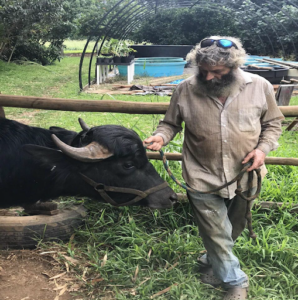
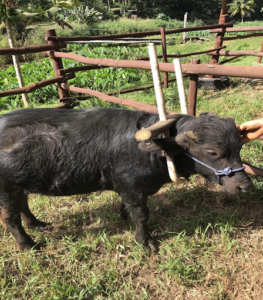
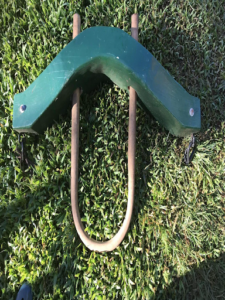
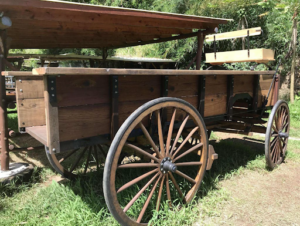
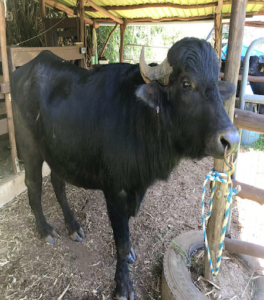
Objective 7: Produced value-added cheese.
Please see the final section of this report for more information on this objective. We plan to start making cheese in the summer of 2024 when our commercial kitchen is completed.
Objective 8: Conducted Educational Outreach
In 2020 an educational PowerPoint presentation was created titled, “Integration of Domestic Water Buffalo into a Whole Farm System on Kaua’i: ecological, economic, and sociocultural benefits”. This was presented at the annual meeting of the Hawaii Farmers Union on October 15, 2020. Later it was discussed on the “Garden and Farming Show” on Kaua’i Public Radio on January 20, 2021. A recorded narration of the presentation was uploaded to Youtube on February 24, 2021 and is currently available to be viewed on Ho’ike, Kaua’i Public Access TV; it is noteworthy that Ho’ke shows this presentation on Kaua’i Public Access TV on a regular basis. Finally, we are drafting an article about this WSARE funded project to be produced for the Hawaii College of Tropical Agriculture and Human Resources quarterly newsletter, in June 2024.
A draft website (www.kauaiorganicagroecosystems.org) for both business and educational purposes will continue to be updated and refined including a consolidated location for videos produced by the farm. Currently farm videos are hosted on Youtube and Archive.org.
On February 22, 2023, 29 members of the Hawaii Farmers Union toured the farm with extensive viewing of the dairy water buffalo herd as well as discussion about their ecological, economic, and social benefits in whole farm systems. On June 19, 2023, Bruce Robinson and his ‘ohana (family) visited KOA Farms specifically to see, and to learn more about, our dairy water buffalo biology, ecology and sustainable business opportunity. See next section for information on collaboration with Gay and Robinson, Inc.
Going Forward: Goals for a nine month, no cost extension of WSARE grant.
With our no cost nine month extension we had hoped to start milking fulltime and making cheese, unfortunately because of the unforeseen increases in costs of building materials and labor costs for our commercial kitchen (Figure 19) we were unable to meet all of our project objectives. We plan to start milking fulltime in May or June 2024, making cheese shortly after. Additionally, the loss of our assistant farm manager, Robert Bristol, who died in October 2023 while visiting his family in Wisconsin, compounded our inability to meet these objective deadlines (i.e., finish training Kekane as a draught buffalo and to complete the Youtube video of making mozzarella cheese from buffalo milk).
Future farm plans and applied research in dairy water buffalo as part of our whole farm system should include the following.
- After completion of the commercial kitchen, start milking on a daily basis (keeping calves with dams), provide fresh raw milk to select herdshare members, and start making cheese (June 2024).
- Hire a professional “ox-drover” to help train select buffalo bulls as draught animals; we will use these draught-trained bulls to puddle, harrow and level our taro pondfields prior to planting; some trained bulls may be provided to other taro farmers.
- Quantify nutritional value of the leaves of many species of trees, grasses, and weeds the buffalo eat, in order to identify the most nutritious forages.
- Expand our dairy buffalo herd both on Kauai (Niumalu on Southshore, Wainiha on Northshore) and on neighbor islands (Oahu, Maui, Molokai and Hawaii Island).
- Document how quickly buffalo can be used to clear land (i.e., girdle and kill invasive trees) and convert invasive forests into grasslands and wetlands.
- Document how buffalo can remove (eat, trample and wallow upon) invasive grassess and weeds in wetlands and improve open water areas and waterbird habitat.
- Conduct long-term growth studies requiring a larger livestock scale to document buffalo growth up to 2-7 years old (our current livestock scale can measure only calves until they reach about 1-1.5 years old; 2 year olds and older are too big to fit on the scale).
- Because half of our calves are bulls, we need to develop a market for our buffalo meat; buffalo meat is lower in calories, lower in cholesterol and higher in iron than beef cattle or bison meat. We recently slaughtered one of our excess 2 yo bulls that yielded 835 lbs of steaks, ribs, organ meats, and ground buffalo worth about $9,000 retail. The meat is excellent!
The formation of an LLC with Gay & Robinson, Inc., or with Bruce and Keith Robinson, in order to significantly increase our buffalo herd size and to expand the market for meat and milk products will also facilitate some of these future research objectives outlined above. G & R’s report to the Hawaii legislative ways and means (WAM) committee is shown in (Figure 20).
Finally, in August or September 2024 KOA Farms plans to start agritourism and have farm tours using our bull Kekane, wearing his yoke and bow, to pull our wagon full of visitors around our taro pondfields, fishponds, and fruit and nut orchards. We are currently drafting a Special Use Permit to the County Planning Department to allow agritourism on KOA Farms. We now realize that some of our objectives did not fit a realistic timeline, since integrated aquaculture (tilapia)- agriculture (taro), agroforestry food production systems like KOA Farms are complex and require special management abilities. KOA Farms integrated tilapia-taro production system (Figure 21) is very productive but requires time and management planning to produce abundant and nutrient-dense food (Figure 22), and provide excellent feeding and nesting habitat for endangered Hawaiian waterbirds (Figure 23).
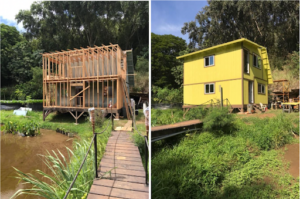
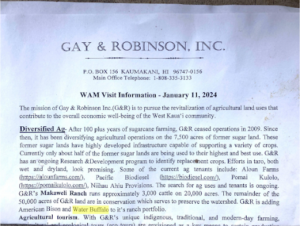
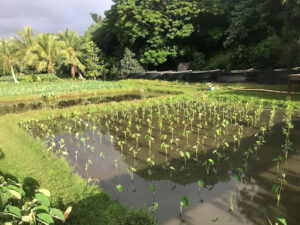
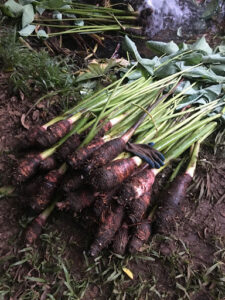
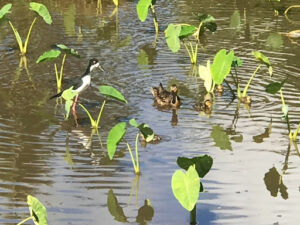
Research Outcomes
Education and Outreach
Participation Summary:
Year 1:
- Five (5) well advertised public PowerPoint presentations entitled, “The potential of dairy water buffalo integration into whole farm systems in Hawaii: economic, environmental and social benefits" (see Supporting Documents), will be given at the Lihue, Kapa’a, and Waimea Public Libraries, to Kauai Community College’s Go Farm program, and to Waipa Foundation during the first year. PowerPoint presentations, and producer/public interactions, will be video-recorded, edited and shown on Public Access Television locally (Ho'ike)and statewide, on YouTube, discussed on Kauai’s Public Radio (KKCR), and written up for local newspapers; factsheets, pamphlets and the Western SARE survey “sign up and outreach survey sheets” will be made available to all attendees at all these public presentations, and another questionnaire (to be developed) will be distributed at these presentations in order to measure producer’s and the public’s specific interest in dairy water buffalo, in their nutritious raw milk, and the possibility of integrating dairy water buffalo into their farms;
- Develop Fact Sheet explaining how dairy water buffalo are gentle, intelligent, and easy to milk and train; how they are biologically and ecologically adapted to tropical/subtropical wet areas, and why they are such a great multi-functional farm animal that can be used for: milk, cheese, meat and fertilizer production, and for plowing, puddling and leveling taro or rice fields, for controlling invasive wetland weeds, restoring endangered water bird habitat, and for logging and transportation; water buffalo also live twice as long as cattle and produce twice the number of calves; this Fact Sheet will be a hand-out at all public PowerPoint presentations;
- Develop dairy water buffalo Pamphlet showing photos of dairy buffalo and all the multi-functional uses they provide for enhancing sustainable whole farm systems;
Year 1-3:
- Four Farm Demonstrations/Workshops/Field days for producers, research/extension agents, and agriculture students will be held on, how to:
(1) Manage and care for your dairy water buffalo: the economic, environmental and social benefits,
(2) Milk a water buffalo, and to sanitize, filter and refrigerate fresh milk and make mozzarella cheese;
(3) Train your water buffalo to be a draft animal: harrow, puddle and level taro pond fields (lo’i);
(4) Develop a GMP, an intensive rotational grazing system and calculate appropriate stocking rate with dairy water buffalo. Additionally, four YouTube videos will be produced primarily from these workshops, with the same titles, over this 3-year project, and posted on YouTube on Year- 3, and incorporated into the final YouTube video on Year-3;
Year-3:
5) Give five (5) final PowerPoint presentations on project’s final research results and recommendations to Lihue and Kapa’a Public Libraries, Kauai Community College’s Go Farm program, the Kauai Chapter Hawaii Farmer’s Union, and the Kauai Farm Bureau); presentations will be video recorded and shown on Hawaii Public Access TV, on YouTube, and written up in local newspapers; Western SARE’s “sign up and outreach survey sheets” and a similar questionnaires (to be developed) that measure producer’s and public’s interest in dairy buffalo or dairy products will be handed out at all presentations;
6) All agrotourists that tour farm will be required to fill out and sign the WSARE Survey form;
7) Edit and produce final YouTube video that incorporates all 4 YouTube videos, overall goals and objectives of the project, and project’s final research findings and recommendations; final YouTube link will be distributed to producer groups, Western SARE, University of Hawaii/CTAHR Extension Agents, Kauai Community College’s Go Farm program, Kauai Chapter of Hawaii Farmer’s Union, Kauai Farm Bureau, the Hawaii Dept. of Agriculture, Sustainable Agriculture Coalition, to all Kauai Public Libraries, and this information will be written up and submitted to local newspapers and discussed on local public radio and TV.
Update 3/10
Conduct Educational Outreach. Developed an educational PowerPoint presentation entitled, “Integration of domestic Water Buffalo into a Taro Farm on Kauai: ecological, economic and
sociocultural benefits” (see YouTube link below). This educational PowerPoint was presented at the annual meeting of the Hawaii Farmer’s Union on October 15, 2020, it was discussed on the “Garden and Farming Show” on Kauai Public Radio on January 20, 2021, and was narrated and presented on YouTube on February 24, 2021 (youtu.be).
Additionally, we have made a video to be placed on YouTube entitled, “Basic Biology, Ecology, Care and Feeding of Dairy Water Buffalo” and plan to place this second PowerPoint on YouTube also in March 2021. Because all public libraries on Kauai were closed due to Covid pandemic these educational venues could not be used for public educational events. Also, KOA has developed a draft website at www.koafarms.org for both business and for educational purposes.
Update 03/08/22
Developed an educational PowerPoint presentation entitled, “Integration of domestic Water Buffalo into a Whole Farm system on Kauai: ecological, economic and sociocultural benefits'' (see YouTube link below). This educational PowerPoint was presented at the annual meeting of the Hawaii Farmer’s Union on October 15, 2020, it was discussed on the “Garden and Farming Show” on Kauai Public Radio on January 20, 2021 and was narrated and presented on YouTube on February 24, 2021 (youtu.be). Additionally, this PowerPoint presentation can be viewed on Ho’ike, Kauai’s Public Access TV program, by going to: Ho’ike.org, then Watch Now, Video On Demand, Videos, then Search (Water Buffalo).
Additionally, we have made a preliminary video of milking our water buffalo that can be viewed on our website (www.kauaiorganicagroecosystems.org). Also, we plan on making another video to be placed on YouTube entitled, “Basic Biology, Ecology, Care and Feeding of Dairy Water Buffalo” within the next month or two. Because all public libraries on Kauai were closed due to Covid pandemic these educational venues could not be used for public educational events. Our draft website (www.kauaiorganicagroecosystems.org) for both business and for educational purposes will continue to be updated and refined. Also, Dr. Birendra and I have drafted an article about this WSARE funded project for publication in the Hawaii College of Tropical Agriculture and Human Resources’ quarterly newsletter.
KOA Farm’s education and outreach, particularly our PowerPoint presentation and YouTube Videos (Intensive Rotational Grazing; How to milk a Dairy Water Buffalo) have engaged a number of large cattle producers and inspired one of the largest former sugar cane companies that own Makaweli Ranch (Gay & Robinson). and Bruce and Keith Robinson (Niihau Ranch), to establish a business partnership (“Kaua’i Buffalo”) with KOA Farms to produce both meat and dairy products. Additionally, KOA Farms has been contacted by Moloka’i Ranch, Hana Ranch (on Maui) and South Mountain Ranch on Hawaii Island, all interested in buying dairy water buffalo from KOA Farms and starting their own herds; another possibility would be to establish a statewide “Hawaii Water Buffalo Cooperative”.
The general public became engaged when they saw KOA Farms dairy water buffalo on Ho’ike, Kaua’i Public Access TV, and our PowerPoint presentation on our website; this has resulted in 65 persons/families wanting to start a herdshare agreement with a bill of sale so that they can gain access to health-promoting organic raw milk. Twenty-one native Hawaiian mahi’ai (farmers) have shown great interest in obtaining dairy water buffalo and using them as tractors, fertilizer producers, weed-eaters, transportation, and milk and cheese producers in remote valleys on Moloka’i (Wailau, Pelekunu) and on Hawaii Island (Laupahoehoe Nui) where no roads exist and tractors and trucks have no access.
